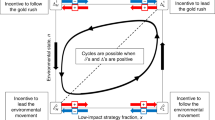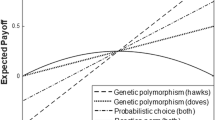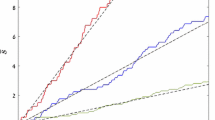Summary
I consider a general model of a fluctuating environment in which the environmental state each year is drawn at random from some given distribution. Each year organisms must choose what action to perform before the environmental state for that year is known. There is no interaction with kin. In this scenario, natural selection will tend to produce organisms which maximize their geometric mean fitness. In this paper I introduce the idea of the profile of a strategy. This function quantifies how the strategy peforms for each environmental state. I show that there is a unique profile such that a strategy is optimal if and only if it has this profile. I then give a characterization of the optimal profile which generalizes previous work by others in this area. The characterization of the optimal profile has a game theoretical interpretation. Motivated by this I introduce a game in which individuals ‘play the field’ in a constant environment. This game may be interpreted as a cooperative game between kin. The key result of this paper shows that a strategy maximizes geometric mean fitness in the original fluctuating environment problem if and only if it is an evolutionarily stable strategy of the deterministic environment game. It is well known that an optimal strategy in a fluctuating environment may be mixed, involving adaptive ‘coin-flipping’. Others have previously noted that this may result in some individuals sacrificing individual reproductive success for the good of the genotype. My analysis shows that one may regain the concept of individual optimization if the quantity maximized is suitably defined. Under an optimal strategy every action taken maximizes the expected number of offspring produced, where this expectation is not calculated using the true distribution of environmental states, but a distribution modified to take account of the actions of kin.
Similar content being viewed by others
References
Bishop, D.T. and Cannings, C. (1978) A generalised war of attrition.J. Theor. Biol. 70, 85–124.
Cooper, W.S. and Kaplan, R.H. (1982) Adaptive ‘coin-flipping’: a decision-theoretic examination of natural selection for random individual variation.J. Theor. Biol. 94, 135–51.
Ellner, S. (1986) Germination dimorphisms and parent—offspring conflict in seed germination.J. Theor. Biol. 123, 173–85.
Grafen, A. (1985) A geometric view of relatedness.Oxford Surveys Evol. Biol. 2, 28–89.
Hammerstein, P. and Selten, R. (1993) Evolutionary game theory. InHandbook of game theory with economic applications (R.J. Aumann and S. Hart, eds). North-Holland.
Lewontin, R.C. and Cohen, D. (1969) On population growth in a randomly varying environment.Proc. Natl Acad. Sci. USA 62, 1056–60.
Maynard Smith, J. (1982)Evolution and the Theory of Games. Cambridge University Press, Cambridge, UK.
Seger, J. and Brockman, H.J. (1987) What is bet-hedging?Oxford Surveys Evol. Biol. 4, 182–211.
Author information
Authors and Affiliations
Rights and permissions
About this article
Cite this article
McNamara, J.M. Implicit frequency dependence and kin selection in fluctuating environments. Evol Ecol 9, 185–203 (1995). https://doi.org/10.1007/BF01237756
Issue Date:
DOI: https://doi.org/10.1007/BF01237756




